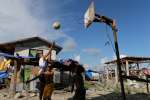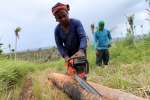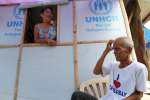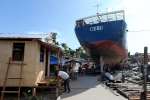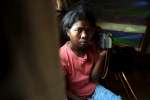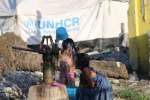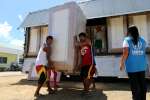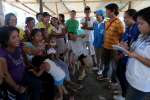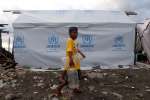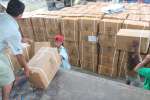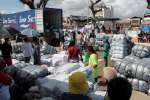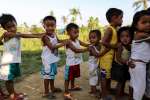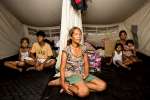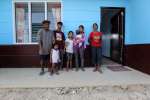Typhoon Haiyan Anniversary: From ship to shore, a story of survival
News Stories, 6 November 2014
TACLOBAN, the Philippines, November 6 (UNHCR) – The big dredger looks menacing as it towers over the houses next to it. Children run around the ship, playing and seemingly unaware of the tragedy that placed it there. Somebody has nonetheless scribbled a message on the ship's hull, which tells a different story: Stupid Yolanda.
The dredger was home to Bartolome and his family, together with 37 other families, for three weeks after Typhoon Haiyan hit the island of Leyte in the Philippines on November 8 last year. Typhoons are not uncommon in the Philippines and, over the years, people have learnt what to do and how to cope. But this was no ordinary typhoon.
Haiyan, locally called Typhoon Yolanda, swept over the central Phillipines with winds of 235 kilometres an hour and was one of the strongest typhoons to have ever hit the Southeast Asia nation. The storm affected around 14 million people and caused extensive damage to property. Entire communities were wiped out and the island of Leyte was especially affected. Thousands of people were killed on Leyte and elsewhere by the super storm.
"No one expected that the typhoon would be that strong. Yolanda was merciless," said Bartolome, sitting in his house built on pillars by the sea. "Everyone was aware that the typhoon was strong but the forecast was not that clear on how strong it would be."
Like many men, Bartolome sent his wife and children to an evacuation centre and stayed behind to guard his house. At his brother-in-law's house they huddled together and began preparing a meal, thinking it was just a question of waiting the storm out. But as the wind and rain increased, they saw the houses around them being blown away and destroyed one by one. Four people knocked on the door and asked to be let in. When the water began to rise they climbed up to the second floor, and then the roof.
"The rain and wind was so hard that it hurt when it touched your skin," said Bartolome. "My body was in pain. That's how strong the typhoon was."
As they were lying on the roof, he prayed that the waves would stop. By this point, they were almost as high as the house. Suddenly, a ship passed by and Bartolome thought that they were being saved. He soon realised that they were not rescuers. The people he saw waving from the ship were also survivors who had climbed onto the vessel.
When UNHCR found Bartolome and his family, they were living on the ship with other families in horrific conditions. They had no choice; their house was completely destroyed, the streets were full of debris and littered with rotting human and animal corpses. The stench was unbearable.
With the support of United Parcel Service (UPS), UNHCR provided Bartolome and his family with a solar-powered lantern, kitchen set, mats and a tent, helping them to move off the ship. As one of UNHCR's leading corporate partners, the shipment and logistics company contributed crucial funds to the immediate response and long-term recovery.
"I'm really thankful to UNHCR," said Bartolome. "They gave us a tent when they stopped by the ship. Not just to us but they also provided tents to other survivors of the whole province. I can't imagine what [the city of] Tacloban would look like without UNHCR and the other organizations."
The dredger remains a part of Bartolome's neighbourhood, reminding him of the awful events of the past. With the support he received from UPS and UNHCR, he quickly regained his strength and was able to swiftly rebuild his house. "I said we would be back in the house by the New Year, and I was right," said Bartolome proudly.
By Marjanna Bergman in Tacloban, the Philippines








